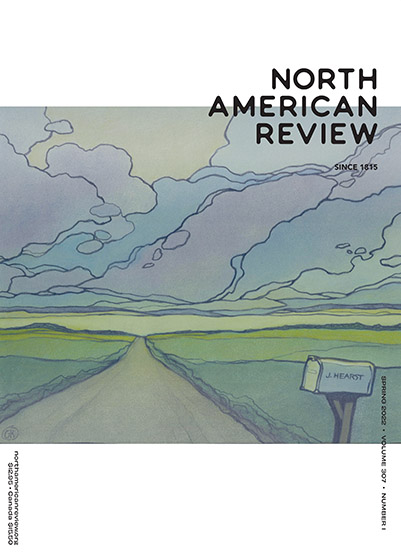
Buy this Issue
Never miss
a thing.
Subscribe
today.
We publish all
forms of creativity.
We like stories that start quickly
and have a strong narrative.
We appreciate when an essay
moves beyond the personal to
tell us something new about
the world.
Subscribe
FROM THE EDITORS
Gary Kelly’s cover art “Spring Rites” invites the longview—a straight Midwestern road narrows into the horizon, a purply-blue sky fills most of the canvas, and a name on a mailbox stands in for a person. How accustomed to this socially distanced and de-peopled setting we’ve become, now in our third spring of living with a novel virus. In his poem “Spring Rites,” the farmer-poet James Hearst observes: “we eat the bread / of body’s earth to invoke the clouds / to send up rain and raise our dead.” Any farmer or poet knows the work of spring is a messy, uncomfortable, difficult business, turning dirt to wheat, seed to flower, death into living again. And yet, it happens, over and over.
Now in its twenty-first year, the James Hearst Poetry Prize celebrates a judge who is special to NAR, Natalie Diaz, whose poem, “Abecedarian Requiring Further Examination of Anglikan Seraphym Subjugation of a Wild Indian Reservation,” was an honorable mention for the 2006 Hearst Prize. More recently, Diaz’s collection Postcolonial Love Poem won the 2021 Pulitzer Prize for Poetry. Diaz selected J. K. Tsosie’s “1997 Southside” as this year’s Hearst winner, an energetic ode to place and identity at a time so specific we can hear the music from open windows and observe the couple from next door have a fight that spills into the street. The runners-up are Robert Wood Lynn and Elisabeth Preston-Hsu, each of whose poems adroitly cast intimate relationships across stark, watery landscapes, a speaker alone considering what it is to love and be loved. Congratulations to all our finalists, whose work appears in this issue.
At the time of this writing, it was a year ago that Amanda Gorman delivered her presidential inauguration poem “The Hill We Climb,” reminding us of all the places and spaces poetry belongs, and we continue that call by celebrating National Poetry Month in April. We’re pleased to publish new work by Sandra Cisneros, whose poem laments the ill-effects of social media, a feeling made all too omnipresent in a pandemic, where portions of our lives are lived on screen.
This issue of NAR also features several diverse and challenging stories. C. E. Poverman’s “Before the N-Word” explores memory (what’s retained, forgotten, and wall-papered over) and tackles white culpability within a scaffolding of Black Lives Matter. It’s an arresting journey, a literary Rorschach test. Marc Dickinson’s “Three Days Discovered” is a crime/literary hybrid, looking into the variety of backstories that surround the death of a young woman (found in an automobile). As in the case of the best crime stories that deal with uncertainties and questions of trust, this one raises more questions than it answers. Congratulations to Frannie Dove, whose “A Twister on Stage 14” is her first published story, a wonderful counterpointed narrative between a World War I veteran and a young man working on the set crew for The Wizard of Oz. The story plays with the mentor trope and provides two surprises of change. Finally, Elizabeth’s Caswell’s “Where Bones Belong” is a genuinely creepy story of parental abuse, a vicious dog, and the burying of secrets. It too is a memory piece and ultimately a story of repression.
Our nonfiction selections are equally wide-ranging. In her essay “Mother-Infant Dyad,” Jennifer Case explores how the science of breastfeeding explains why women need a community to support this beautiful, natural, but also exhausting labor. In Patrick Hicks’s essay, a visit to the Berlin Wall offers the opportunity to meditate on the history of fascism and the terror of its return. Finally, in N. D. Brown’s “Nine Rules of an Icon Painter,” an anonymous found text on iconography scaffolds the story of a childhood friend lost to suicide.
This issue’s featured artist is Mary Wagner, who creates drawings using handmade gears, reminiscent of a familiar childhood toy. What starts as a simple line of ink is elevated through repetition and layering of patterns. The color and density of her designs lend meaning to the overall feeling they elicit from the viewer. The mixed media piece “Sanctuary” layers gold paint in an ink blot formation over the clear repetitive pattern in black and white. The variable perception of this piece pairs well with a short story about people recalling the same events in very different ways, dark and light sharing space.
As America’s longest-lived literary magazine, we are often confronted with moments—some painful and some hopeful—to contend with America’s progressive and regressive histories. Not only does our archive tie us to this history, but the very name of our journal, the North American Review is connected to the land the magazine was founded on. This issue has given us the opportunity to more thoroughly understand and acknowledge the ancestral stewards of the land where we edit and publish. We are adding the following statement to the masthead in perpetuity: The NAR is housed on the ancestral lands of the Iowa, Sauk and Fox, Sioux, Omaha, and Ho-Chunk, as well as those tribal nations who are contemporary caretakers of land in Iowa, including the Meskwaki: Sac and Fox Tribe of the Mississippi in Iowa.
As these Spring days offer more minutes of light each day, we are sending this issue out to you with the same hope: more space and minutes to create light and art, to behold what we’ve together brought into being. ⬤

